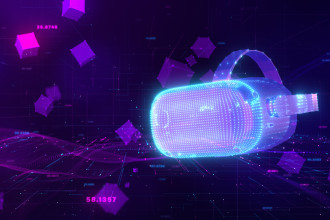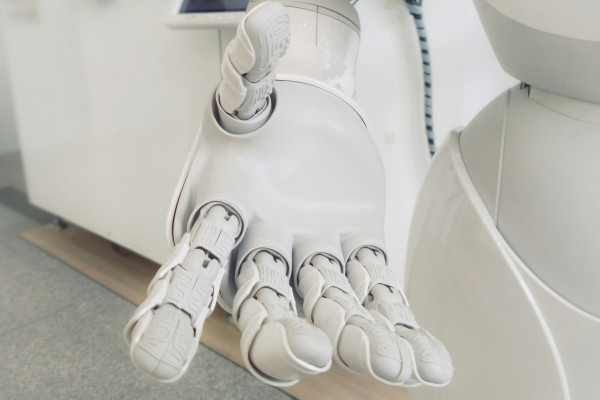What drives us to talk about robotics? ensun aims to speed up global business progress. Our web crawlers gather data, and our text-based algorithms organize it systematically. By combining our internal data with external sources, we offer insights into the latest technologies and spotlight the top innovators behind them.
For this report, we've analyzed over 328+ relevant companies within the robotics sector.
The encyclopedia Britannica explains robots “as any automatically operated machine that replaces human effort, though it may not resemble human beings in appearance or perform functions in a humanlike manner. By extension, robotics is the engineering discipline dealing with the design, construction, and operation of robots.”
With this in mind, let’s dive into forecasted developments for robotics.
Projected Advances in Robotics Technology
The world is facing a significant challenge: a growing labor shortage. A report by the ManpowerGroup highlights this issue, with the percentage of companies experiencing difficulty filling jobs doubling between 2015 and 2023, rising from 38% to a staggering 77%. This shortage puts a strain on industries, impacting production and efficiency.
In response to this challenge, companies are increasingly turning to industrial robotics. Globally, the market for these automated workers is booming, with a projected growth from $55 billion in 2020 to a staggering $165 billion by 2028. This surge reflects the growing need for solutions that can fill the gaps left by the labor shortage.
While some fear that robots might take away people's jobs entirely, the reality is likely to be more nuanced. Instead of complete replacement, automation is more likely to lead to a shift in the workforce. As robots handle repetitive and potentially dangerous tasks, human workers will need to become more specialized. They'll focus on areas that require critical thinking, problem-solving, and human interaction, complementing the capabilities of robots.
Transitioning towards a more automated future will have a significant impact on the economy and everyday life. An increase in efficiency through robotics could lead to lower production costs and potentially even lower prices for consumers. However, there's also the potential for job displacement in some sectors. Careful planning and investment in retraining programs will be crucial to ensure a smooth transition for the workforce and minimize negative impacts on people's lives.
Simply put, innovation is essential for any company's future success in this industry. Those that can't adapt to the labor shortage and keep up with new developments will likely fall behind.
New Robotic Technologies and Their Top Innovators
Cloud Robotics
Cloud robotics is part of robotic integration and leverages cloud technologies to enhance robot capabilities. By connecting to the cloud, robots can access powerful computation, storage, and communication resources from modern data centers, enabling them to process and share information across multiple robots or agents.
However, challenges arise due to the limitations imposed by the robots' physical attributes and the difficulty in modifying their configurations post-deployment. Despite these hurdles, cloud robotics finds application in diverse fields like healthcare, manufacturing, transportation, and personalization, where it boosts processing power, facilitates knowledge access, and enables collaboration among robots, thereby driving efficiency and innovation.
Top Innovators
- Robotics Technologies offers cutting-edge IT services, including Advanced Vision Processing for robotics and custom automation equipment. They serve diverse industries with tailored solutions.
- Robotise provides robotics solutions for partners like LMU Klinikum, Radisson Blu Zurich Airport, and Leonardo Hotels. Their innovations, such as the hotel robot JEEVES, streamline processes and enhance efficiency across industries.
- Galactica uses Computer Vision and AI for insights from Satellite and UAV imagery. Their customizable platform addresses remote sensing challenges seamlessly.
Autonomous Mobile Robot
Autonomous mobile robots operate as part of ai-driven robotics, so without human control. Notable early examples are Elmer and Elsie, constructed in the late 1940s by W. Mobile robots, on the other hand, are driven by software and equipped with sensors and technology to navigate their surroundings. Combining artificial intelligence (AI) with physical elements like wheels or legs, these robots can identify their environment and move autonomously.
They find application in various sectors, including:
- Hospitals
- Distribution Centers
- Cleaning and Disinfection
- Grocery Stores
- Last Mile Delivery
Top Innovators
- incubed IT develops innovative software for autonomous, cooperative mobile shuttles. Their expertise in robotics and multi-agent systems ensures tailored solutions for diverse applications.
- Mojin Robotics GmbH aims to extend intelligent robotics technologies beyond factories, facilitating intuitive user interaction and enhancing productivity and service quality in the service sector to maintain global competitiveness.
- FARobot specializes in designing, producing, and distributing Swarm Autonomy solutions. Their goal is to empower enterprise intralogistic automation by providing brand-agnostic robotic workforces.
Social Robotics
Social robots, driven by AI and adept at human interaction, represent a significant leap in robotics technology. With sensors mimicking human senses, these robots, exemplified by Ameca, offer lifelike expressions despite limitations in mobility. As advancements continue, their integration across industries promises to reshape productivity and efficiency paradigms.
The future of social robots holds immense potential, with their applications spanning diverse sectors from healthcare to manufacturing. As they seamlessly collaborate with humans and other robots, their impact on productivity and efficiency is poised to redefine modern workplaces, heralding a new era of technological innovation.
Top Innovators
- Dex-Lab creates lifelike humanoid robots for sectors like elder care, aiming to revolutionize services. They focus on innovative dementia intervention in Singapore to improve elderly individuals' quality of life.
- LuxAI creates affordable and user-friendly socially assistive robots. Their flagship product, QTrobot, helps children with autism and special needs develop social, emotional, and communication skills.
Cognitive Robotics
Cognitive Robotics is a branch of robotics focused on making robots smarter by enabling them to learn and make decisions in complex environments. In the medical field, robots serve diverse roles, including surgical assistance, aiding individuals with mobility challenges, and managing medication dispensation. These advancements in robotic technology are revolutionizing healthcare practices, enhancing precision, and optimizing patient care delivery.
Medical robots are reshaping the healthcare landscape by performing a range of tasks such as surgery, rehabilitation assistance, and medication management. Through innovations in robotics, these technologies are streamlining medical procedures, improving treatment outcomes, and enhancing patient experiences.
Top Innovators
- Traversal enhances heavy industry productivity through cognitive robotics, leveraging advanced technologies like Vision AI and spatial computing to optimize processes and increase efficiency.
- NEXT Robotics provides innovative lightweight robotics solutions, integrating artificial intelligence for collaborative stationery and mobile robotics. They engage in collaborative research projects through their New Technology Network (NTn) to address technical challenges.
Nanorobotics
Nanoid robotics is an emerging field focused on creating machines called nanorobots or nanobots, whose components operate at or near the nanometer scale. These tiny robots hold great potential in various applications, including healthcare and medicine. For instance, nanobots could revolutionize health monitoring by detecting subtle health indicators such as weak arterial walls or early signs of organ failure, enabling early intervention and prevention of diseases.
Furthermore, nanobots offer the advantage of molecular processing, allowing them to function at the atomic or molecular level to build devices, machines, or circuits. They also have the capability of self-replication, wherein they can produce copies of themselves to replace worn-out units. These features open possibilities for highly efficient and self-sustaining systems, promising advancements in nanotechnology and beyond.
Top Innovators
- Klocke Nanotechnik offers advanced nanotechnology solutions, including the “Nanofinger®” sensor with atomic precision and a patented Nanomotor for centimeter-scale positioning.
- DNA-Robotics focuses on DNA-Based Modular Robotics to scale advanced robotic behavior to the molecular level for medical and technological applications.
Autonomous Forklift
An autonomous forklift is a cutting-edge solution that operates without human intervention, utilizing advanced technologies like SLAM for navigation and obstacle avoidance. These forklifts streamline material handling processes, improving efficiency and productivity in various industries. With different types available, including warehouse, counterbalance, and telehandler, forklifts cater to diverse material handling needs, ensuring smooth operations. While they require initial investment and maintenance, the benefits of increased productivity and safety outweigh any drawbacks. Overall, autonomous forklifts represent a positive step forward in modernizing logistics and warehouse management.
Top Innovators
- Mojin Robotics GmbH specializes in autonomous mobile robots (AMR) for intralogistics, providing flexible, safe, and reliable end-to-end automation solutions.
- Cyngn boosts industrial fleet productivity by 33% with DriveMod, enabling autonomous operations for goods transport, heavy hauling, and safe navigation.
- Fox Robotics is a mid-stage startup pioneering warehouse automation with advanced forklift technology, including trailer unloading capabilities.
Navigating Technological Evolution
In summary, the robotics industry is undergoing significant advancements in 2024, driven by innovations aimed at addressing labor shortages and enhancing efficiency across sectors. These developments promise a future marked by increased productivity and efficiency. But robotics is not the only field evolving. Our B2B search engine unveils you suppliers for the exact technology you are looking for – globally and inter-industrial.
Start searching here now.
FAQ about Robotics
The convergence of robotic technology with various complementary technologies such as machine vision, force sensing, speech recognition, and advanced mechanics is opening up new horizons of functionality. This enables robots to perform tasks that were previously deemed impractical, ushering in exciting possibilities for automation.
The four main types of robotics are industrial robotics, service robotics, military robotics, and mobile robotics. Industrial robots are utilized in manufacturing processes, while service robots aid humans in tasks such as cleaning and healthcare. Military robots serve defense and security purposes, while mobile robots are capable of moving around their environment and are used in exploration and logistics.
The three C's of robotics are collaboration, cooperation, and coordination. Collaboration involves robots working alongside humans, assisting them directly or indirectly. Cooperation refers to robots working together with each other or with humans to achieve shared objectives. Coordination entails synchronizing movements and actions among robots or between robots and humans to accomplish tasks efficiently.
The hardest part of robotics often lies in achieving robustness and adaptability in real-world environments. This involves designing robots that can effectively perceive and interpret their surroundings, make decisions based on this information, and execute tasks accurately and reliably amidst uncertainties and dynamic conditions. Additionally, ensuring safety, reliability, and ethical considerations present significant challenges in the development and deployment of robotic systems.
With a legacy spanning more than three decades, iRobot has solidified its position as a prominent global player in robotics and consumer goods. Through relentless pursuit of innovation, the company has curated a revolutionary range of robotic solutions, reshaping numerous industries along the way.
Quickscout
Auf der Suche nach
passenden Technolgie-Anbietern?
Beginne jetzt mit dem Scouting!





